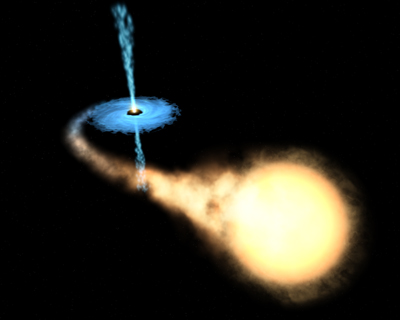Black holes as their name is really black. When an object approaches a certain distance from a black hole, it will be swallowed forever with no chance of escape. This includes light, meaning black holes do not emit light
(Translation: Dikla Oren)

Black holes as their name is really black. When an object approaches a certain distance from a black hole, it will be swallowed forever with no chance of escape. This includes light, meaning black holes do not emit light.
How do astronomers discover black holes if they can't be seen? Well, to be precise, astronomers don't discover black holes. However, they do discover phenomena, whose existence can only be explained through the existence of nearby objects, whose properties correspond to the properties of the black hole!
The pull of the black hole's strong gravitational forces has an effect on the motion of objects close to it. When astronomers see a star orbiting something, but are unable to see the thing it orbits, they may suspect that it is a black hole or a neutron star - the "corpse" of an extremely dense star.
Astronomers can even deduce the mass of the black hole by measuring the star's mass and velocity. The same kind of calculation can be done with supermassive black holes, which reside at the centers of many galaxies including our own, the Milky Way galaxy.
In the Milky Way, observations have revealed the existence of gas and stars, moving at very high speed near the center. This behavior can only be explained by the assumption that in the center of the galaxy there is a mass several billion times greater than the mass of our sun.
Such a mass must be concentrated within a radius of at most 10 light days. This is about forty times the distance between the Sun and Pluto - and this mass is most likely a black hole.
In fact, right at the center of our galaxy, radio and X-ray telescopes have discovered a powerful macro, called Sagittarius A, and identified as a suitable candidate to be this black hole.
This idea recently received supporting evidence with the measurement of the orbit of a star, which approaches the mysterious object up to a distance of 17 light hours - only three times the distance between the Sun and Pluto - and at the same time moves at a speed of about 5000 km per second!
Another evidence in favor of the existence of extremely massive black holes in the center of the galaxy is the existence of quasars, discovered in 1967. Quasars are very distant and yet very bright objects - the brightest objects in the entire universe.
To explain the huge amount of energy that quasars must release, astronomers need black holes as well: just before disappearing into a black hole, the swallowed material heats up and emits huge amounts of energy - its last call. So it is thought that quasars are caused by black holes with a mass of one million to several billion solar masses.
It is best to discover the last reading of the material about to be swallowed with the help of telescopes in the radio and X-ray fields, since the energy is released in the form of X-rays. In fact, the ESA (European Space Agency) XMN-Newton and Integral observation missions have already shown their skills in studying black holes with several discoveries.
For example, the XMN-Newton recently discovered a small spinning black hole in our galaxy, in the constellation Ara in the southern sky. Integral has discovered what may be the first significant emission of X-rays from the black hole at the center of our galaxy.
